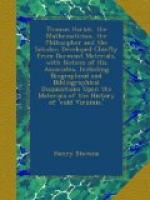had matured his plans, secured his grant, and in 1576
made his first voyage to find the north west passage.
The same year the half-brother of Raleigh, Sir Humphrey
Gilbert, published his ‘discourse for a discouerieof
a new passage to Catai,’ with a map showing
the coast of North America, and the passage to China.
This was the result of years of study, and though
the elaborate work was written out hastily at last,
we know that while others were advocating the north
east passage, Sir Humphrey always persisted in the
north western. Frobisher’s expedition is
said to have been an outgrowth of Gilbert’s
efforts and petitions. These projects were long
in hand, but Gilbert, in June 1578, obtained his famous
patent from Elizabeth for two hundred leagues of any
American coast not occupied by a Christian prince.
This grant was limited to six years, to expire the
eleventh of June 1584 in case no settlement was made
or colony founded. The story of Gilbert’s
efforts, expenditures of himself and friends, his unparalleled
misfortunes and death, need not be retold here.
Part of his rights and privileges fell to his half-brother
Walter Raleigh who had participated somewhat in the
enterprise. After Gilbert’s death and before
the expiration of the patent, Raleigh succeeded in
obtaining from Elizabeth another patent, with similar
rights, privileges, and limitations, dated the 25th
of March 1584, leaving the whole unoccupied coast open
to his selection. On the 27th of April, only
a month later, he despatched two barks under the command
of Captains Amadas and Barlow, to reconnoitre the
coast, as Ribault had done, for a suitable place to
plant a colony, somewhere between Florida and Newfoundland.
This patent also, like Gilbert’s, in case of
negligence or non-success, was limited to six years.
But it required the confirmation of Parliament.
Though there were many rival interests, some of which
had perhaps to be conciliated, the patent was confirmed.
It ought perhaps to be mentioned here that five of Gilbert’s six years having already expired without his obtaining success or possession, several others, anticipating a forfeiture of the patent, began agitation for rival patents in 1583. Carleil, Walsingham, Sidney, Peckham, Raleigh, and perhaps others were eager in the strife. Mostof the papers are given in Hakluyt’s 1589 edition. The ’ Golden Hinde ’ returned in September 1583 with the news of the utter failure of the expedition and the death of Sir Humphrey. Raleigh succeeded in obtaining the royal grant, and then all the rest joined him in getting the patent confirmed by Parliament.




